Genre: Educational Developer: Electronic Arts Canada Publisher: Electronic Arts Players: 1 Released: 1992
High Alert at the Federal Time Travel Commission! Supercriminal Carmen Sandiego and her crime syndicate, the Villain’s International League of Evil (V.I.L.E.) have stolen a time machine. Now, her evil operatives set out to change the course of history by travelling to certain key events in time and stealing important historic artifacts or landmarks. In order to apprehend these criminals, the ACME Detective Agency has been commissioned to crack the case, and they have hired you, the player, to set things straight again. Equipped with a Chronoskimmer, you set out across time and space, hunting for clues and questioning witnesses in order to catch these crooks, working through the ranks of VILE operatives until you get at the mastermind herself, the nefarious Carmen Sandiego! But beware. In order to prevent major disruptions in the time stream, the Federal Time Travel Commission only grants you limited time travel time. Can you keep history in check?
Brøderbund managed to accomplish something rather rare with the Carmen Sandiego series. The company created a series of games directed at kids and young teens that not only were educational but also actually kind of fun! Similar to its predecessor Where in the World is Carmen Sandiego, the game creates a fictional “case” where you need to arrest a member of VILE. You need to locate the person who is hiding at a certain time and place in history and has also left behind a sort of breadcrumb trail throughout the timeline you need to follow.
In order to arrest the twerp, you also need a warrant. For that, you need to painstakingly pick out clues that help you identify the person you’re looking for: whether the criminal male or female, what color of hair does he or she have, etc. You enter the clues in your in-game database – once you have the gender and at least two or three identifying marks better double-check with the dossiers to complete the rest if necessary), you can get a warrant by hitting “compute.” Once you have a warrant and you know where in the timestream a villain is hiding out, you can send a robot to make an arrest; however, you only have a limited amount of “hours,” which don’t represent real time but are rather a fixed number you get assigned for each individual case. These are lowered for every time you travel, for each warrant you request and for each arrest attempt made. Run out of hours and the criminal escapes, leading to an instant game over. The more you advance in the game, the more locations you have to visit before meeting up with the criminal at large, so these limited time travel hours become more precious with each case. So you better make sure you don’t travel to the wrong time period or location, don’t get a warrant for the wrong person, or send the arrest robot to the wrong period in time.
The investigation usually goes like this: You start out at a certain time and place. Your “chronoskimmer” – the in-game GUI – has four menus. Abort is used if you’re completely lost and want to start the entire mission over again. Data is where you enter the clues about the twerp you’re currently after, information like the sex, color of hair, color of eyes, his or her favorite artist and the favorite author. You can also find dossiers of the known members of VILE in there, as well as change the language settings of the game. Hints and clues are acquired with the search option, which allows you to talk to witnesses and informants present at the current location or using the scanner to search for clues. The hints provided are rarely direct: Usually they tell you stuff like “she had eyes the color of slate” (meaning grey), “he read a book by England’s first Nobel Prize winner,” or “he wanted to talk with Cervantes about Windmills.” Travel is used to pick your next destination, which provides you with four possible options. If you chose the correct time and location, a little animation plays that signifies you’re on the right track.
Certain editions of the game had the box in a cardboard sleeve, bundled together with an encyclopedia. This is where the educational part of this crime mystery plot comes in. Let’s take the aforementioned example about the criminal “wanting to talk with Cervantes about Windmills.” If you don’t know who Cervantes, take out the encyclopedia and look him up. So you learn that Miguel Cervantes was the author of Don Quixote, lived in Spain, was born in 1547, and died in 1616. So now you have a rough time frame in which the next potential lived in. Go to the travel menu, and one of the available options should be “Spain 1300 – 1700.” This is where you need to go next. If you choose the wrong period and/or location, you won’t find any useful information there, no matter how often you consult your search menu. At least each new place or time period has some additional interesting descriptive information the first time you visit, even if it doesn’t necessarily tie into the case at hand. All in all, there are 12 different locations with four time periods each accessible in this game.
The thing is, this game absolutely has to be played with an almanac of some sort at hand. Unless you already have exhaustive general knowledge about history, geography, art, and literature, you will have to look up more information somewhere about the clues you get. When I first played the game, I had rented it, and I got it without the additional book. Luckily, we had a lexicon at hand, only it came in 24 different issues lettered along the alphabet, so researching individual persons always took a while. Nowadays, complete copies including the cardboard sleeve and the original accompanying “New American Desk Encyclopedia” might be hard to come by (I’ve heard that for the German market a copy of the “Fischer Weltalmanach” was included instead, though whether that applied only to home computer releases or the Mega Drive version as well I couldn’t confirm). Of course, in this day and age, playing the game on the console and keeping Wikipedia at hand on a nearby tablet works just as well. Considering the game actually wants you to look up the information you need, this might actually be the preferable option. One thing I loved about the game when I first played it as a teenager was that it comes in five different languages. Your time travelling crime mystery can be played in English, German, French, Italian and Spanish; there also was a Portuguese release for the Brazil market.
The game just has one major disadvantage. The missions all pretty much play out the same. Names and locations may differ from case to case, but there are no changes to the proceedings. The investigation and the chain of locations you need to follow just get increasingly longer. After about ten cases or so, a certain tedium tends to set in, and you start to wish for some variety. And this is a looooong game. Only after successfully making 80 (!) arrests can this game be considered beaten. Considering that there are only about 16 different suspects and 48 different locations, sooner or later the game will start to repeat itself. Also, progress is saved via passwords, but be extra careful when writing them down. They aren’t terribly long, but the font wasn’t particularly well picked. Played on a CRT TV screen, some letters are hard to discern, and it can be hard to tell an H from an N or an I from a T.
Played for too long on end, the allure of solving time travel related criminal cases may run dry after a while. But for an educational game, Where in Time is Carmen Sandiego? is pretty entertaining. By embedding them in fictional criminal cases, both historical and geographical data are provided in fun and interesting ways. By urging you to research or look up additional information by yourself in order to solve the individual cases, the game actively and effectively encourages the player to learn. Being able to play in five different languages is also a big plus. Better yet, since this is a game that first and foremost tries to teach (or let’s rather say “encourage learning”) history, it hasn’t lost much of its relevance even though it was released more than 20 years ago. It may not contain any “new” post-1990 information, but what’s there still conveys some solid common knowledge.
SCORE: 7 out of 10


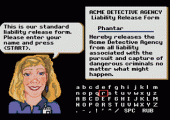
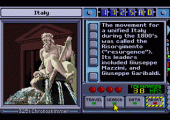
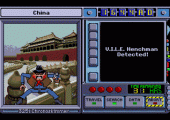
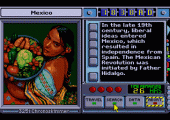
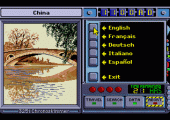
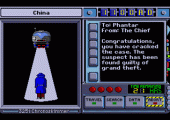
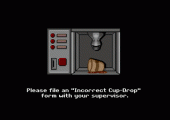

Recent Comments